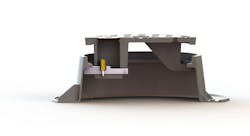To close out 2024, Locksmith Ledger released our annual State of the Industry report where we asked locksmiths for their thoughts on key topics around their business, including market and product areas where they are seeing the most growth, and technologies and trends they are most excited or concerned about. The roundtable webcast discussion to start 2025 featured Wayne Winton, owner of Tri County Locksmith Service, who is an Industry expert in locksmithing and education; Glenn Younger, owner of San Diego, Calif.-based Grah Safe and Lock, who has worked in the security, access control and life safety field since 1974; and Chad Lingafelt, managing partner, Loc-Doc Security, who is well-respected in the industry for his work building Loc-Doc to the success it is today.
In the following recap (see the full video of the webcast on locksmithledger.com/webinars), this talented panel discusses current trends in the locking and access control world, such as the continued move to electronic access, the rise of smart locks, biometrics and mobile access, new products, technology and services, finding the next generation of locksmiths, training opportunities in 2025, and more.
Rise of Electronic Access Control
The rise of electronic access control within the physical access control sector has been well-documented within these pages, as locksmiths continue to diversify their product portfolio to include the latest and greatest technological innovations.
“This is the year of biometrics,” says Winton. “I have been hesitant to really recommend facial recognition or fingerprint biometric locks, but I think that we are at a point to where it's ready. It's really working very well in the residential market, and it's ready in the commercial [sector] as well. I really see things going in that direction. Also, anything that you can do with your smartphone obviously is what people want. They want to be able to see who's coming and going and everybody wants control over their security and the products are now finally matching that.”
As Winton points out, locksmiths can make more money working on, installing and selling access control products than strictly doing rekeying jobs, for example. “I can tell you that it actually quadruples your business because you make more on that initial sale instead of a $35 rekey, I'm installing a $500 electronic access lock that probably cost me $135,” he says.
Lingafelt agrees about the importance of locksmiths diversifying their portfolio to include electronic access control, and the continued ubiquity of the smartphone as a preferred credential.
“For the past three years, this [holds up phone] is my only credential to get into my home to drive my car, to get into my business. I have not carried a physical key for my vehicle or my business or my home in over three years,” says Lingafelt. “I think the biggest aspect of that is diversification, so when you're talking about access control, it sounds shiny and fresh and new and we can talk about biometrics and facial recognition, all those things. But as a business, if you're thinking in terms of how to weave that in to be profitable, so there can be some recurring revenue associated with it as well, you really must think through diversification. Can I service the entire opening, or am I just servicing one element of it? If you're only servicing one element, then you have backed yourself into a corner where you are potentially falling prey to those types of those changes in the marketplace.”
Looking at recurring revenue opportunities with the addition of electronic access control solutions, Younger notes, “Recurring revenue is kind of a new topic for many in the locksmith industry and I think there's different ways to do it. Most locksmiths start off as a service break-fix model as opposed to a project installation model. And once you get into more project installation, RMR starts to build up.”
Winton adds, “You're basically turning a service back into a product and making money on it every single year. And if you don't have RMR or monthly recurring revenue, you don't have much to sell when you go to sell your business, so people really need to keep that in mind. If you can show a nice monthly check that just comes in either through service contracts through customers that you have or through the alarm monitoring or through the access control systems that you provide, then you've got something tangible that people want and your investors will really see that as a shining star.”
Lingafelt agrees, especially when looking long-term in terms of exit strategies, which is a growing area of concern for locksmiths in the Locksmith Ledger 2024 State of the Industry Report (see graph).
“Contracts are huge when you're talking mergers and acquisition … companies have been stating this out for years,” he explains. “If you want to go sell your business on exit strategy, the best way to get a higher multiple is to have contracts, and our industry lacks that. I would also look at it from a percentage standpoint. When I start to look at my functional business, no matter what the size is, what is the percentage that I would like to cover with recurring monthly revenue? A really strong number is 25% of your annual revenue would be covered under recurring, but you have to start somewhere to get there. We currently sit at about 14% of our annual revenue through recurring, to say for every $100 that we generate, $14 of it is already recurring.”
He continues, “So as an industry that relies on turning a wrench to generate revenue, any way that you can look at your business model to find an opportunity to generate revenue while you're sleeping is a great path for long term success and scalability. Because at times you may want to take a vacation, you may want to allow your employees to take vacations. So having that revenue is going to be one element to allow you to get to that point.”
Business of Locksmithing
Purchasing and staying on top of the latest products and relationship with distributors, manufacturers and their reps is a big area of focus locksmiths, as those relationships can often dictate the overall success of a business.
“We're really talking about is the rise of the vertical-specific business development rep, often funded by a distributor, manufacturer or even a manufacturer's rep group,” says Younger. “With the amount of consolidation that we're having in the lock world, a locksmith specific world with the big three [lock manufacturers] there used to be a lot more independent reps than there are now. Each of the big three now have sales staff far bigger than they used to, and they've got vertical-specific user reps that are calling on their contacts for multifamily housing, for schools, etc. So, the reps can become your unpaid salespeople is the point I'm trying to make. If you want to expand your sales force, the fastest, easiest, cheapest way for you to do it is to become an ally with your manufacturers’ reps, especially those who are growing in verticals that you would like to grow.”
Winton agrees, pointing out that working closely with and gaining the trust of these partners can make a big difference in your business lead generation.
“A manufacturer can have the most durable product in the world, the most convenient product in the world, but if it's not installed properly, it will not perform and your customer will not be happy,” says Winton. “If I can prove to the manufacturer and to the distributors and to the end users that we are the best solution and I can install these locks, faster and more accurately than anybody else in my area, they're going to bring that business to me. We invest in the proper jigs, we invest in the proper products, we take our time, and we install the product exactly to the manufacturer specifications and they recognize that and bring the business directly to us. That's how you land the big projects.”
Lingafelt agrees with both Younger and Winton on the importance of having solid partnerships with manufacturers and distributors.
“[They are] Out there pushing and driving, that's what they are motivated to do” he says. “That's what they're incentivized to do is to create those relationships and those opportunities for an installer, a dealer. As wholesalers, manufacturers and dealers and installers, we should be able to work seamlessly together to ultimately provide a solid solution to an end user to where they are happy, and they are now becoming fans of that product and of that company and they're promoting it for us.”
Marketing and Branding
When it comes to marketing and branding your company, Lingafelt says locksmiths need to understand their customer’s pain points and speak to them in a language they can understand.
“I am going to share the biggest piece of advice that I learned years ago, and it broke my brain when I first heard it, but it has transformed the way that we communicate with our customers and the way that we are trying to market our business. We operate on a scale of one to 10 that's called the curse of knowledge. And as industry experts, we talk and communicate – and you just heard a lot of it here on this webcast – we talk at a level 9-10, when we are talking about RMR and biometrics and facial recognition – all this high-level knowledge. A customer, the general consumer, buys at a Level 1 or a level 2 and the big key factor of all this is when we do our best to simplify and really break this down, we typically land at about a 5 or 6, so we're still shooting over the heads of our target audience. So how do you break down the messaging so that it really hits their pain point and doesn't talk on the knowledge level and over explain.”
Lingafelt emphasizes that your message should be easy to digest and be able to be understood by a stranger in that initial meeting right away, like a sniff test he says.
Winton adds that using social media can be a powerful tool to build your brand and business, and Google can be both your friend and enemy.
“If you start diversifying now, you can Google-proof your business,” Winton says. “I did a whole keynote presentation on this where I talked about how you have those surface contracts in place – if you have Facebook ads running, TikTok ads running, Instagram ads running, your recurring revenue – then all your eggs are not in that proverbial Google basket. And if you're listing drops, because that is a big thing that is happening right now, as the locksmith industry is under assault from Google, and they are taking down ads or they're taking listings down left and right over tiny infractions because of the problems with the scammers. Anybody can lose their Google business listing overnight if you are not prepared for that and can’t survive that you are not prepared to be in business in 2025.”
Exit Strategy and Finding New Talent
One area that continues to increase in importance for locksmiths is having an exit strategy, which jumped from 8% to nearly 19% (see graph) in our 2024 SOI report.
“There's so many people out there that haven't even done a business plan,” says Winton. “At the ALOA Convention, Mark Dawson and I held an after-hour seminar on business building. When we went around the room and asked people how many people had an actual written business plan, nobody had a written business plan and I think that is a huge detriment to yourself, your business and the industry as a whole. If you don't know where you're going and you don't have a map, you're not going to get there. Why would an employee want to work for somebody if they don't have any direction as to where that company and business is going?”
Lingafelt agrees and provides some sage advice for attracting good talent to the industry and your company.
“A lot of people are looking for stability, a consistent paycheck, decent benefits and a place that they enjoy working, yet we can't figure out how to provide that,” he says. “We have to figure out how to shift our mindset over to how do we make our businesses appealing for people to come work for? What is our training? How do we really focus on a good training program that we can give people those tools in a faster amount of time? It does not appeal to anybody to sit and ride in the van for 12 to 16 months to hopefully potentially learn what they need to learn over that period of time. The faster that you figure that out and create a path to where you're not the ceiling of the organization and you're not stopping people from growing, then you have a way for people to come on board and be excited.”
Diving deeper into the training side of things, Lingafelt adds, “I would go through and list out the top 15 things that I would want this new hire to know within their first 30 days or six months, etc. Don't get stuck on the number, but a specific number of tasks that they should be able to perform on their own within a set number of days and then I would review that with them on a regular basis. Task them with the responsibility of owning that list and learning it.”
Younger agrees, adding, “You can resource those manufacturers and wholesalers – they all are offering training on a regular basis. Next, how do you figure out in your shop or your warehouse to build your own training environment? I have a cabinet that has 250 lessons – it's an apprenticeship course. As Chad said, figure out the 15 or 20 things that are important that you need them to know before they are working by themselves, for example. And it can take two months or can take two years, but you've got to have these 20 things under your belt. And, of course, leverage training from manufacturers and distributors every chance you get if they want to have a higher-level training.”
Paul Ragusa | Senior Editor
Paul Ragusa is senior editor for Locksmith Ledger. He has worked as an editor in the security industry for nearly 10 years. He can be reached at [email protected].





